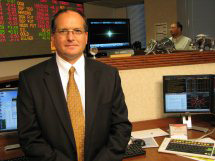With high-frequency trading firms having become de facto market makers, buy-side traders are concerned about the resultant shrinking order sizes, market fragmentation and potential for information leakage.
“We don’t engage in high-speed algorithmic trading, but we do get involved in some names that are targets of the high-speed trading networks,” said Michael Earlywine, head trader, North America, at Ecofin. “To that degree, we need to make sure we understand it.”
Ecofin, a $1.2 billion investment management firm headquartered in London, specializes in public and private investments into the worldwide utility, infrastructure, energy and alternative energy sectors. Its funds include hedge funds, long-only funds, private equity and debt funds, and bespoke institutional mandates.
“In my opinion the problems stem from the proliferation of exchanges with different rebate policies, causing HFTs to shop exchanges in order to capture rebates,” said Earlywine. “We have gotten to the point where the underlying trade is nothing but a rebate vehicle. They are not providing liquidity, they are capturing rebates. Price discovery should be the primary motivator, not rebates.”
Sell-side firms with large institutional customer bases are sensitized to the need to insulate clients from the vicissitudes—perceived or real—associated with HFT.
“There is good liquidity and bad liquidity,” said John Donahue, senior vice-president and head of equity at Fidelity Capital Markets, the institutional trading arm of Fidelity Investments.
“As an agency broker, we have an obligation to work with our clients to make sure they avoid toxic liquidity even at the expense of commissions. Best execution dictates that we isolate and locate the best liquidity available to match the strategy that a client is using. If the strategy is to achieve as much liquidity in the shortest possible time, we can do that. If strategy is to achieve liquidity over a longer time horizon, we can do that too.”
The HFT Question
High-frequency trading is characterized by rapid submission and cancellation of orders, and the absence of long-term positions in a particular stock. Orders are typically generated by algorithms, using smart order routing technology to sniff out potential liquidity.
Changes in market structure brought on by decimalization and greater competition among exchanges have led to a fundamental change in the pricing model used by exchanges, in particular a move away from payment for order flow (PFOF) to maker-taker pricing. A variant, taker-maker, also known as the inverted model, charges fees to liquidity providers and pays rebates to liquidity takers.
Equity options exchanges in the U.S. use one of two models to execute marketable orders: the maker-taker model or the PFOF model. Exchanges utilizing the PFOF model use order flow payments to attract marketable retail orders.
Focusing solely on execution prices, the cost of liquidity on exchanges utilizing the PFOF model is 80 basis points higher than on exchanges utilizing maker-taker pricing, according to a 2012 paper by Robert Battalio, professor at Mendoza College of Business at the University of Notre Dame in Indiana.
Nevertheless, when taker fees are incorporated into the analysis, the cost of liquidity on the PFOF exchanges is 74 basis points lower.
“Our results have two implications,” said Battalio. “Transparency and competition in equity options markets appear to have limited the potential agency problems, and evaluations of market quality that ignore taker fees can be misleading.”
The Next Best Thing
Despite the declining volumes and order sizes that have come to characterize the equities markets in 2012-13, buy-side traders remain unfazed about the onset of algorithmic trading, and have even come to embrace it.
“I would not describe current market conditions as difficult to source liquidity relative to similar historic market environments,” said Steve Hedger, managing director of trading and investment operations at Fifth Third Asset Management, the institutional asset management subsidiary of Fifth Third Bank. “The tools we use to source liquidity have not changed or grown that much over the last five years, and we have not seen or heard anything from our brokerage coverage of the ‘next best thing’.”

Steve Hedger, managing director of trading and investment operations, Fifth Third Asset Management
Still, there is no denying that the buy side is constrained in sourcing liquidity in current markets.
“The same issues persist and are only magnified in a low volume environment: continued fragmentation, smaller average trade size on lit markets and increased scrutiny around dark liquidity,” said Jason Crosby, global head of portfolio sales and head of Americas institutional execution services sales at Bank of America Merrill Lynch. “Accessing true natural liquidity such as retail flow has also been increasingly challenging.”
Bank of America Merrill Lynch has launched Instinct Natural, an enhancement to its alternative trading system Instinct X, aimed at increasing opportunities to execute block trades while minimizing market impact.
“We want to make it easier for our clients to find liquidity so we’ve built a central platform where natural flow can interact,” said Crosby. “With Instinct Natural, clients can tap the vast, uncorrelated natural order flow that comes through our firm. We expect this will quickly become the place to go for size and price improvement.”
Instinct Natural allows the client the opportunity to leverage the liquidity from institutional and private clients trading with BofA Merrill’s high-touch, electronic, ETF and equity derivatives desks.
Instinct Natural works by having the buy-side trader rest conditional placements in Instinct X and await an invitation to firm up. BofA Merrill believes that as clients become more willing to rest longer in Instinct Natural, they’ll find natural crosses with price and size improvement and minimal market impact.
